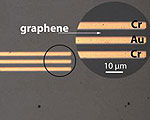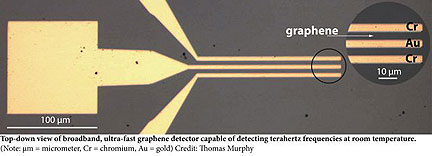Terahertz Detector Could Lead to Safer Medical Imaging
 Sep-09-14
A graphene-based prototype device able to detect terahertz waves while at room temperature could lead to a new generation of non-invasive security scanners and safer medical imaging.
Sep-09-14
A graphene-based prototype device able to detect terahertz waves while at room temperature could lead to a new generation of non-invasive security scanners and safer medical imaging.Terahertz waves can pass through opaque materials like skin and plastics without the potentially damaging side-effects of traditional x-rays. But most conventional terahertz detectors have needed to be kept extremely cold, and units that do function at room temperature have been large and prohibitively expensive.
The new detector, which can operate at room temperature, was created using a sheet of graphene only one atom thick. Graphene is made up of lattice-like structure, which allows its electrons to absorb light and retain the heat energy rather than release it back into the structure. As the heated electrons leave the graphene through electrical leads, they create an electrical signal that detects the presence of terahertz waves beneath the surface of opaque materials.

More Info about this Invention:
[GIZMAG.COM][CMNS.UMD.EDU]

Add Your Comment